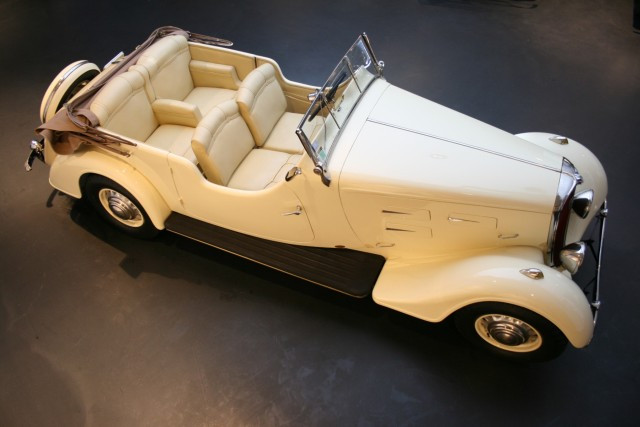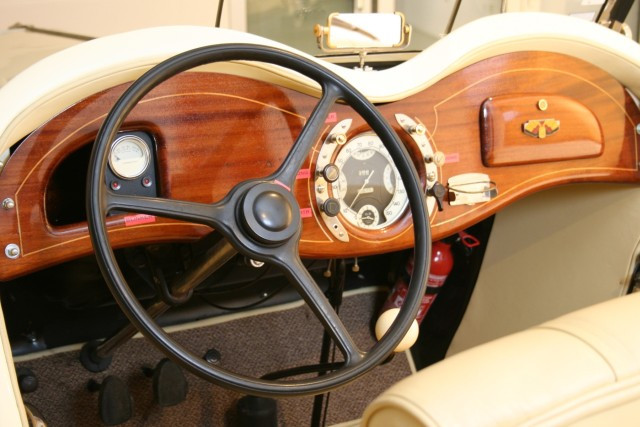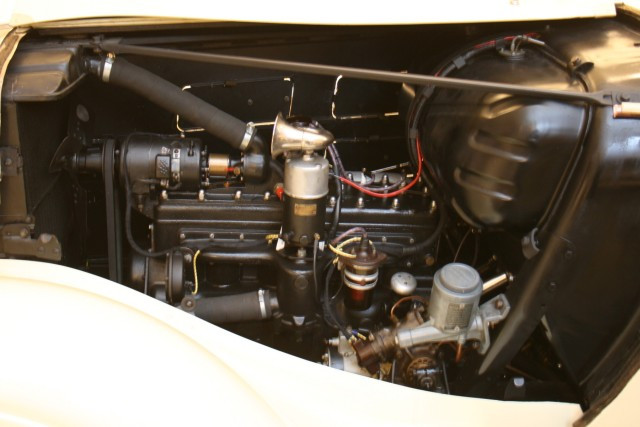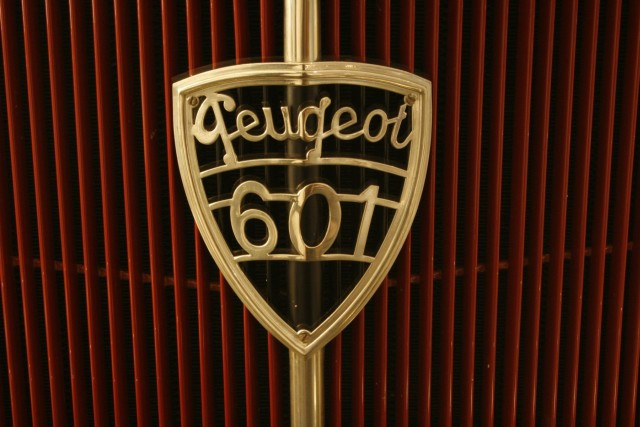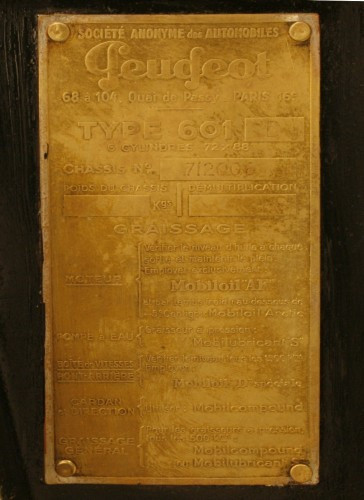Sale Rétromobile - 04 february 2011 /Lot 290 1936 PEUGEOT 601 D TORPEDO GRAND SPORT TM
1936 PEUGEOT 601 D TORPEDO GRAND SPORT TM Carrosserie Meulemeester
Châssis n° 712 006
Grâce au succès de la 201 présentée au Salon de Paris 1929, l'avenir de la marque est bien assuré malgré la crise partie de Wall Street presque à la même date. Ses effets atteindront gravement la France en 1931 et 1932, mais Peugeot a eu le bon produit au bon moment. Sur cette base saine qu'elle dote bientôt d'une suspension avant indépendante en option, la marque développe une gamme très complète de carrosseries de tourisme et commerciales, puis une 8 CV en 1932 et une 10 CV en 1934, non sans progresser sur le plan technique avec les châssis Bloctube. Mais entre-temps, et comme pour nier la crise, février 1934 apporte une nouvelle six-cylindres à l'étude depuis 1932, mais retardée. Il s'agit de recentrer la gamme vers le haut, sans revenir aux coûteux sans-soupapes ni à la 12-Six mal aimée et, surtout, de se positionner face aux Renault Vivasport et aux Citroën " 15 " même si le marché est étroit et les prévisions de vente modestes. La nouvelle 601 offre une moteur six cylindres de 2,2 litres qui, malgré ses soupapes latérales, développe 60 ch réels en souplesse et en silence, c'est à dire autant que les " six " de la concurrence tout en n'étant taxé que pour 12 CV. Les premières 601 du printemps 1934 ont le tort de ressembler trop aux 301 et d'être trop étroites pour un modèle qui se veut luxueux. De fait, la production ne dépassera pas 4 000 exemplaires en tout jusqu'au Salon 1935 où la 402 " fuseau Sochaux " frappa les visiteurs par sa vraie ligne aérodynamique et son moteur moderne. Entre-temps, la 601 avait un peu évolué en suivant le style maison marqué par un profilage encore timide, sinon primitif et caractérisé par quelques détails sans efficacité réelle comme l'abaissement des phares, les ailes à jupe ou l'allongement de l'arrière avec intégration du coffre.
Si la 601 souffre de sa ressemblance avec ses sœurs plus modestes, elle recevra en bénéficiant de la longueur de son capot de jolies carrosseries sport (roadster, coach profilé ou aérodynamique, berlines profilées, coupé décapotable) qui, traitées luxueusement, lui seront propres. Et les carrossiers indépendants sauront jouer de son beau et long profil, sans oublier le modèle Eclipse de Georges Paulin construit par Marcel Pourtout, avec son toit électrique qui rentre dans le coffre du premier coupé-cabriolet de l'histoire.
La voiture présentée peinte en blanc avec intérieur en cuir beige, ici est encore plus rare, sinon unique. Elle est due à la Carrosserie des frères Meulemeester, Alsaciens établis à Clichy (Paris) qui iront s'installer à St-Affrique dans l'Aveyron en 1936. C'est là que le châssis 601 D de 307 cm d'empattement n° 712 006 est livré en février de la même année pour son premier propriétaire, Louis Aussel de Roquefort, qui commande une torpédo de style britannique, un vrai tourer quatre places à portes échancrées et pare-brise rabattable. Proposée par annonce presse en 1996, la voiture est achetée en 1997 par un amoureux du modèle marqué dans son enfance par les 601 familiales. La 601 Torpédo Sport bénéficiera d'une restauration totale et scrupuleuse qui s'achèvera en 2005. En 2008, elle est acquise en vente publique. C'est une voiture originale à l'histoire intéressante dans un très bel état.
Carte grise française.
Thanks to the success of the 201 exhibited at the Paris Motor Show in1929, the future of the brand was well assured despite the Wall Street Crash, which happened at almost the same date. Its consequences seriously affected France in 1931 and 1932, but Peugeot had the right product at the right time. On top of this healthy basis it soon had optional independent front suspension and the brand developed a very full range of tourism and commercial bodies, then an 8 CV in 1932 and a 10 CV in 1934, not without improving on a technical level with the Bloctube chassis. But in the meantime, and as if to refute the crisis, February 1934 brought a new six-cylinder model that had been in the design process since 1932, but had been delayed. It was a matter of refocusing the range upwards, without returning to the expensive valveless engines or to the unloved 12-Six and, above all, of positioning itself with the Renault Vivasport and the Citroën 15, even if the market was narrow and the sales forecasts modest. The new 601 offered a 2.2 litre six-cylinder engine which, despite its side valves, developed 60 real hp in flexibility and in silence; that is to say, as much as the competition six while being taxed only for 12 CV. The first 601s of spring 1934 had the error of looking too much like the 301s and of being too narrow for a model which sees itself as luxurious. In fact, production did not exceed 4000 models in total until the Motor Show in 1935, where the 402 "Sochaux rocket" struck visitors with its real aerodynamic lines and its modern engine. In the meantime, the 601 had slightly changed according to the in-house style marked by shy, if not primitive streamlining, characterised by some details without any real effectiveness such as the lowering of the headlights, the fender skirts or the lengthening of the rear while incorporating the boot.
Though the 601 suffers from its similarity to its more modest sisters, it receives, while benefiting from its long body, pretty sports bodies (roadster, streamlined or aerodynamic coach, streamlined saloons, convertible coupé) which, lavishly treated, are unique to it. And independent body builders know how to make the most of its beautiful, long profile, not forgetting the Eclipse model by Georges Paulin built by Marcel Pourtout, with its electric roof which disappears into the boot of the first coupé-cabriolet in history.
The car being exhibited, painted white with an interior in beige leather, is even rarer here, if not unique. This car came about thanks to the Body Workshop of the brothers Meulemeester, Alsatians based in Clichy (Paris), and who later went to settle at St-Affrique in the departement of Aveyron in 1936. It was there that the chassis 601 D with a 307 cm wheelbase no. 712 006 was delivered in February of the same year for its first owner, Louis Aussel de Roquefort, who ordered a British style torpédo, a real four-seater tourer with low-cut doors and a folding windscreen. Announced in an advertisement in the press, the car was bought in 1997 by a lover of the model who had been impressed by the family 601s in his childhood. The 601 Sports Torpédo benefited from a meticulous restoration which ended in 2005. In 2008, it was bought at auction. It is an original car with an interesting history and is in very good condition.
It comes with its French vehicle registration document.
Estimation 75 000 - 95 000 €
Sold 73,123 €
* Results are displayed including buyer’s fees and taxes. They are generated automatically and can be modified.
Châssis n° 712 006
Grâce au succès de la 201 présentée au Salon de Paris 1929, l'avenir de la marque est bien assuré malgré la crise partie de Wall Street presque à la même date. Ses effets atteindront gravement la France en 1931 et 1932, mais Peugeot a eu le bon produit au bon moment. Sur cette base saine qu'elle dote bientôt d'une suspension avant indépendante en option, la marque développe une gamme très complète de carrosseries de tourisme et commerciales, puis une 8 CV en 1932 et une 10 CV en 1934, non sans progresser sur le plan technique avec les châssis Bloctube. Mais entre-temps, et comme pour nier la crise, février 1934 apporte une nouvelle six-cylindres à l'étude depuis 1932, mais retardée. Il s'agit de recentrer la gamme vers le haut, sans revenir aux coûteux sans-soupapes ni à la 12-Six mal aimée et, surtout, de se positionner face aux Renault Vivasport et aux Citroën " 15 " même si le marché est étroit et les prévisions de vente modestes. La nouvelle 601 offre une moteur six cylindres de 2,2 litres qui, malgré ses soupapes latérales, développe 60 ch réels en souplesse et en silence, c'est à dire autant que les " six " de la concurrence tout en n'étant taxé que pour 12 CV. Les premières 601 du printemps 1934 ont le tort de ressembler trop aux 301 et d'être trop étroites pour un modèle qui se veut luxueux. De fait, la production ne dépassera pas 4 000 exemplaires en tout jusqu'au Salon 1935 où la 402 " fuseau Sochaux " frappa les visiteurs par sa vraie ligne aérodynamique et son moteur moderne. Entre-temps, la 601 avait un peu évolué en suivant le style maison marqué par un profilage encore timide, sinon primitif et caractérisé par quelques détails sans efficacité réelle comme l'abaissement des phares, les ailes à jupe ou l'allongement de l'arrière avec intégration du coffre.
Si la 601 souffre de sa ressemblance avec ses sœurs plus modestes, elle recevra en bénéficiant de la longueur de son capot de jolies carrosseries sport (roadster, coach profilé ou aérodynamique, berlines profilées, coupé décapotable) qui, traitées luxueusement, lui seront propres. Et les carrossiers indépendants sauront jouer de son beau et long profil, sans oublier le modèle Eclipse de Georges Paulin construit par Marcel Pourtout, avec son toit électrique qui rentre dans le coffre du premier coupé-cabriolet de l'histoire.
La voiture présentée peinte en blanc avec intérieur en cuir beige, ici est encore plus rare, sinon unique. Elle est due à la Carrosserie des frères Meulemeester, Alsaciens établis à Clichy (Paris) qui iront s'installer à St-Affrique dans l'Aveyron en 1936. C'est là que le châssis 601 D de 307 cm d'empattement n° 712 006 est livré en février de la même année pour son premier propriétaire, Louis Aussel de Roquefort, qui commande une torpédo de style britannique, un vrai tourer quatre places à portes échancrées et pare-brise rabattable. Proposée par annonce presse en 1996, la voiture est achetée en 1997 par un amoureux du modèle marqué dans son enfance par les 601 familiales. La 601 Torpédo Sport bénéficiera d'une restauration totale et scrupuleuse qui s'achèvera en 2005. En 2008, elle est acquise en vente publique. C'est une voiture originale à l'histoire intéressante dans un très bel état.
Carte grise française.
Thanks to the success of the 201 exhibited at the Paris Motor Show in1929, the future of the brand was well assured despite the Wall Street Crash, which happened at almost the same date. Its consequences seriously affected France in 1931 and 1932, but Peugeot had the right product at the right time. On top of this healthy basis it soon had optional independent front suspension and the brand developed a very full range of tourism and commercial bodies, then an 8 CV in 1932 and a 10 CV in 1934, not without improving on a technical level with the Bloctube chassis. But in the meantime, and as if to refute the crisis, February 1934 brought a new six-cylinder model that had been in the design process since 1932, but had been delayed. It was a matter of refocusing the range upwards, without returning to the expensive valveless engines or to the unloved 12-Six and, above all, of positioning itself with the Renault Vivasport and the Citroën 15, even if the market was narrow and the sales forecasts modest. The new 601 offered a 2.2 litre six-cylinder engine which, despite its side valves, developed 60 real hp in flexibility and in silence; that is to say, as much as the competition six while being taxed only for 12 CV. The first 601s of spring 1934 had the error of looking too much like the 301s and of being too narrow for a model which sees itself as luxurious. In fact, production did not exceed 4000 models in total until the Motor Show in 1935, where the 402 "Sochaux rocket" struck visitors with its real aerodynamic lines and its modern engine. In the meantime, the 601 had slightly changed according to the in-house style marked by shy, if not primitive streamlining, characterised by some details without any real effectiveness such as the lowering of the headlights, the fender skirts or the lengthening of the rear while incorporating the boot.
Though the 601 suffers from its similarity to its more modest sisters, it receives, while benefiting from its long body, pretty sports bodies (roadster, streamlined or aerodynamic coach, streamlined saloons, convertible coupé) which, lavishly treated, are unique to it. And independent body builders know how to make the most of its beautiful, long profile, not forgetting the Eclipse model by Georges Paulin built by Marcel Pourtout, with its electric roof which disappears into the boot of the first coupé-cabriolet in history.
The car being exhibited, painted white with an interior in beige leather, is even rarer here, if not unique. This car came about thanks to the Body Workshop of the brothers Meulemeester, Alsatians based in Clichy (Paris), and who later went to settle at St-Affrique in the departement of Aveyron in 1936. It was there that the chassis 601 D with a 307 cm wheelbase no. 712 006 was delivered in February of the same year for its first owner, Louis Aussel de Roquefort, who ordered a British style torpédo, a real four-seater tourer with low-cut doors and a folding windscreen. Announced in an advertisement in the press, the car was bought in 1997 by a lover of the model who had been impressed by the family 601s in his childhood. The 601 Sports Torpédo benefited from a meticulous restoration which ended in 2005. In 2008, it was bought at auction. It is an original car with an interesting history and is in very good condition.
It comes with its French vehicle registration document.
Estimation 75 000 - 95 000 €
Sold 73,123 €
* Results are displayed including buyer’s fees and taxes. They are generated automatically and can be modified.
Lot 290
1936 PEUGEOT 601 D TORPEDO GRAND SPORT TM
Lot 290
Sold 73,123 € [$]
1936 PEUGEOT 601 D TORPEDO GRAND SPORT TM Carrosserie Meulemeester
Châssis n° 712 006
Grâce au succès de la 201 présentée au Salon de Paris 1929, l'avenir de la marque est bien assuré malgré la crise partie de Wall Street presque à la même date. Ses effets atteindront gravement la France en 1931 et 1932, mais Peugeot a eu le bon produit au bon moment. Sur cette base saine qu'elle dote bientôt d'une suspension avant indépendante en option, la marque développe une gamme très complète de carrosseries de tourisme et commerciales, puis une 8 CV en 1932 et une 10 CV en 1934, non sans progresser sur le plan technique avec les châssis Bloctube. Mais entre-temps, et comme pour nier la crise, février 1934 apporte une nouvelle six-cylindres à l'étude depuis 1932, mais retardée. Il s'agit de recentrer la gamme vers le haut, sans revenir aux coûteux sans-soupapes ni à la 12-Six mal aimée et, surtout, de se positionner face aux Renault Vivasport et aux Citroën " 15 " même si le marché est étroit et les prévisions de vente modestes. La nouvelle 601 offre une moteur six cylindres de 2,2 litres qui, malgré ses soupapes latérales, développe 60 ch réels en souplesse et en silence, c'est à dire autant que les " six " de la concurrence tout en n'étant taxé que pour 12 CV. Les premières 601 du printemps 1934 ont le tort de ressembler trop aux 301 et d'être trop étroites pour un modèle qui se veut luxueux. De fait, la production ne dépassera pas 4 000 exemplaires en tout jusqu'au Salon 1935 où la 402 " fuseau Sochaux " frappa les visiteurs par sa vraie ligne aérodynamique et son moteur moderne. Entre-temps, la 601 avait un peu évolué en suivant le style maison marqué par un profilage encore timide, sinon primitif et caractérisé par quelques détails sans efficacité réelle comme l'abaissement des phares, les ailes à jupe ou l'allongement de l'arrière avec intégration du coffre.
Si la 601 souffre de sa ressemblance avec ses sœurs plus modestes, elle recevra en bénéficiant de la longueur de son capot de jolies carrosseries sport (roadster, coach profilé ou aérodynamique, berlines profilées, coupé décapotable) qui, traitées luxueusement, lui seront propres. Et les carrossiers indépendants sauront jouer de son beau et long profil, sans oublier le modèle Eclipse de Georges Paulin construit par Marcel Pourtout, avec son toit électrique qui rentre dans le coffre du premier coupé-cabriolet de l'histoire.
La voiture présentée peinte en blanc avec intérieur en cuir beige, ici est encore plus rare, sinon unique. Elle est due à la Carrosserie des frères Meulemeester, Alsaciens établis à Clichy (Paris) qui iront s'installer à St-Affrique dans l'Aveyron en 1936. C'est là que le châssis 601 D de 307 cm d'empattement n° 712 006 est livré en février de la même année pour son premier propriétaire, Louis Aussel de Roquefort, qui commande une torpédo de style britannique, un vrai tourer quatre places à portes échancrées et pare-brise rabattable. Proposée par annonce presse en 1996, la voiture est achetée en 1997 par un amoureux du modèle marqué dans son enfance par les 601 familiales. La 601 Torpédo Sport bénéficiera d'une restauration totale et scrupuleuse qui s'achèvera en 2005. En 2008, elle est acquise en vente publique. C'est une voiture originale à l'histoire intéressante dans un très bel état.
Carte grise française.
Thanks to the success of the 201 exhibited at the Paris Motor Show in1929, the future of the brand was well assured despite the Wall Street Crash, which happened at almost the same date. Its consequences seriously affected France in 1931 and 1932, but Peugeot had the right product at the right time. On top of this healthy basis it soon had optional independent front suspension and the brand developed a very full range of tourism and commercial bodies, then an 8 CV in 1932 and a 10 CV in 1934, not without improving on a technical level with the Bloctube chassis. But in the meantime, and as if to refute the crisis, February 1934 brought a new six-cylinder model that had been in the design process since 1932, but had been delayed. It was a matter of refocusing the range upwards, without returning to the expensive valveless engines or to the unloved 12-Six and, above all, of positioning itself with the Renault Vivasport and the Citroën 15, even if the market was narrow and the sales forecasts modest. The new 601 offered a 2.2 litre six-cylinder engine which, despite its side valves, developed 60 real hp in flexibility and in silence; that is to say, as much as the competition six while being taxed only for 12 CV. The first 601s of spring 1934 had the error of looking too much like the 301s and of being too narrow for a model which sees itself as luxurious. In fact, production did not exceed 4000 models in total until the Motor Show in 1935, where the 402 "Sochaux rocket" struck visitors with its real aerodynamic lines and its modern engine. In the meantime, the 601 had slightly changed according to the in-house style marked by shy, if not primitive streamlining, characterised by some details without any real effectiveness such as the lowering of the headlights, the fender skirts or the lengthening of the rear while incorporating the boot.
Though the 601 suffers from its similarity to its more modest sisters, it receives, while benefiting from its long body, pretty sports bodies (roadster, streamlined or aerodynamic coach, streamlined saloons, convertible coupé) which, lavishly treated, are unique to it. And independent body builders know how to make the most of its beautiful, long profile, not forgetting the Eclipse model by Georges Paulin built by Marcel Pourtout, with its electric roof which disappears into the boot of the first coupé-cabriolet in history.
The car being exhibited, painted white with an interior in beige leather, is even rarer here, if not unique. This car came about thanks to the Body Workshop of the brothers Meulemeester, Alsatians based in Clichy (Paris), and who later went to settle at St-Affrique in the departement of Aveyron in 1936. It was there that the chassis 601 D with a 307 cm wheelbase no. 712 006 was delivered in February of the same year for its first owner, Louis Aussel de Roquefort, who ordered a British style torpédo, a real four-seater tourer with low-cut doors and a folding windscreen. Announced in an advertisement in the press, the car was bought in 1997 by a lover of the model who had been impressed by the family 601s in his childhood. The 601 Sports Torpédo benefited from a meticulous restoration which ended in 2005. In 2008, it was bought at auction. It is an original car with an interesting history and is in very good condition.
It comes with its French vehicle registration document.
Estimation 75 000 - 95 000 €
Sold 73,123 €
* Results are displayed including buyer’s fees and taxes. They are generated automatically and can be modified.
Châssis n° 712 006
Grâce au succès de la 201 présentée au Salon de Paris 1929, l'avenir de la marque est bien assuré malgré la crise partie de Wall Street presque à la même date. Ses effets atteindront gravement la France en 1931 et 1932, mais Peugeot a eu le bon produit au bon moment. Sur cette base saine qu'elle dote bientôt d'une suspension avant indépendante en option, la marque développe une gamme très complète de carrosseries de tourisme et commerciales, puis une 8 CV en 1932 et une 10 CV en 1934, non sans progresser sur le plan technique avec les châssis Bloctube. Mais entre-temps, et comme pour nier la crise, février 1934 apporte une nouvelle six-cylindres à l'étude depuis 1932, mais retardée. Il s'agit de recentrer la gamme vers le haut, sans revenir aux coûteux sans-soupapes ni à la 12-Six mal aimée et, surtout, de se positionner face aux Renault Vivasport et aux Citroën " 15 " même si le marché est étroit et les prévisions de vente modestes. La nouvelle 601 offre une moteur six cylindres de 2,2 litres qui, malgré ses soupapes latérales, développe 60 ch réels en souplesse et en silence, c'est à dire autant que les " six " de la concurrence tout en n'étant taxé que pour 12 CV. Les premières 601 du printemps 1934 ont le tort de ressembler trop aux 301 et d'être trop étroites pour un modèle qui se veut luxueux. De fait, la production ne dépassera pas 4 000 exemplaires en tout jusqu'au Salon 1935 où la 402 " fuseau Sochaux " frappa les visiteurs par sa vraie ligne aérodynamique et son moteur moderne. Entre-temps, la 601 avait un peu évolué en suivant le style maison marqué par un profilage encore timide, sinon primitif et caractérisé par quelques détails sans efficacité réelle comme l'abaissement des phares, les ailes à jupe ou l'allongement de l'arrière avec intégration du coffre.
Si la 601 souffre de sa ressemblance avec ses sœurs plus modestes, elle recevra en bénéficiant de la longueur de son capot de jolies carrosseries sport (roadster, coach profilé ou aérodynamique, berlines profilées, coupé décapotable) qui, traitées luxueusement, lui seront propres. Et les carrossiers indépendants sauront jouer de son beau et long profil, sans oublier le modèle Eclipse de Georges Paulin construit par Marcel Pourtout, avec son toit électrique qui rentre dans le coffre du premier coupé-cabriolet de l'histoire.
La voiture présentée peinte en blanc avec intérieur en cuir beige, ici est encore plus rare, sinon unique. Elle est due à la Carrosserie des frères Meulemeester, Alsaciens établis à Clichy (Paris) qui iront s'installer à St-Affrique dans l'Aveyron en 1936. C'est là que le châssis 601 D de 307 cm d'empattement n° 712 006 est livré en février de la même année pour son premier propriétaire, Louis Aussel de Roquefort, qui commande une torpédo de style britannique, un vrai tourer quatre places à portes échancrées et pare-brise rabattable. Proposée par annonce presse en 1996, la voiture est achetée en 1997 par un amoureux du modèle marqué dans son enfance par les 601 familiales. La 601 Torpédo Sport bénéficiera d'une restauration totale et scrupuleuse qui s'achèvera en 2005. En 2008, elle est acquise en vente publique. C'est une voiture originale à l'histoire intéressante dans un très bel état.
Carte grise française.
Thanks to the success of the 201 exhibited at the Paris Motor Show in1929, the future of the brand was well assured despite the Wall Street Crash, which happened at almost the same date. Its consequences seriously affected France in 1931 and 1932, but Peugeot had the right product at the right time. On top of this healthy basis it soon had optional independent front suspension and the brand developed a very full range of tourism and commercial bodies, then an 8 CV in 1932 and a 10 CV in 1934, not without improving on a technical level with the Bloctube chassis. But in the meantime, and as if to refute the crisis, February 1934 brought a new six-cylinder model that had been in the design process since 1932, but had been delayed. It was a matter of refocusing the range upwards, without returning to the expensive valveless engines or to the unloved 12-Six and, above all, of positioning itself with the Renault Vivasport and the Citroën 15, even if the market was narrow and the sales forecasts modest. The new 601 offered a 2.2 litre six-cylinder engine which, despite its side valves, developed 60 real hp in flexibility and in silence; that is to say, as much as the competition six while being taxed only for 12 CV. The first 601s of spring 1934 had the error of looking too much like the 301s and of being too narrow for a model which sees itself as luxurious. In fact, production did not exceed 4000 models in total until the Motor Show in 1935, where the 402 "Sochaux rocket" struck visitors with its real aerodynamic lines and its modern engine. In the meantime, the 601 had slightly changed according to the in-house style marked by shy, if not primitive streamlining, characterised by some details without any real effectiveness such as the lowering of the headlights, the fender skirts or the lengthening of the rear while incorporating the boot.
Though the 601 suffers from its similarity to its more modest sisters, it receives, while benefiting from its long body, pretty sports bodies (roadster, streamlined or aerodynamic coach, streamlined saloons, convertible coupé) which, lavishly treated, are unique to it. And independent body builders know how to make the most of its beautiful, long profile, not forgetting the Eclipse model by Georges Paulin built by Marcel Pourtout, with its electric roof which disappears into the boot of the first coupé-cabriolet in history.
The car being exhibited, painted white with an interior in beige leather, is even rarer here, if not unique. This car came about thanks to the Body Workshop of the brothers Meulemeester, Alsatians based in Clichy (Paris), and who later went to settle at St-Affrique in the departement of Aveyron in 1936. It was there that the chassis 601 D with a 307 cm wheelbase no. 712 006 was delivered in February of the same year for its first owner, Louis Aussel de Roquefort, who ordered a British style torpédo, a real four-seater tourer with low-cut doors and a folding windscreen. Announced in an advertisement in the press, the car was bought in 1997 by a lover of the model who had been impressed by the family 601s in his childhood. The 601 Sports Torpédo benefited from a meticulous restoration which ended in 2005. In 2008, it was bought at auction. It is an original car with an interesting history and is in very good condition.
It comes with its French vehicle registration document.
Estimation 75 000 - 95 000 €
Sold 73,123 €
* Results are displayed including buyer’s fees and taxes. They are generated automatically and can be modified.
Sale’s details
Sale: 1957
Date: 04 Feb. 2011 19:00
Date: 04 Feb. 2011 19:00
Contact
Absentee Bids
& Telephone Bids
Kristina Vrzests
Phone +33 1 42 99 20 51
bids@artcurial.com
